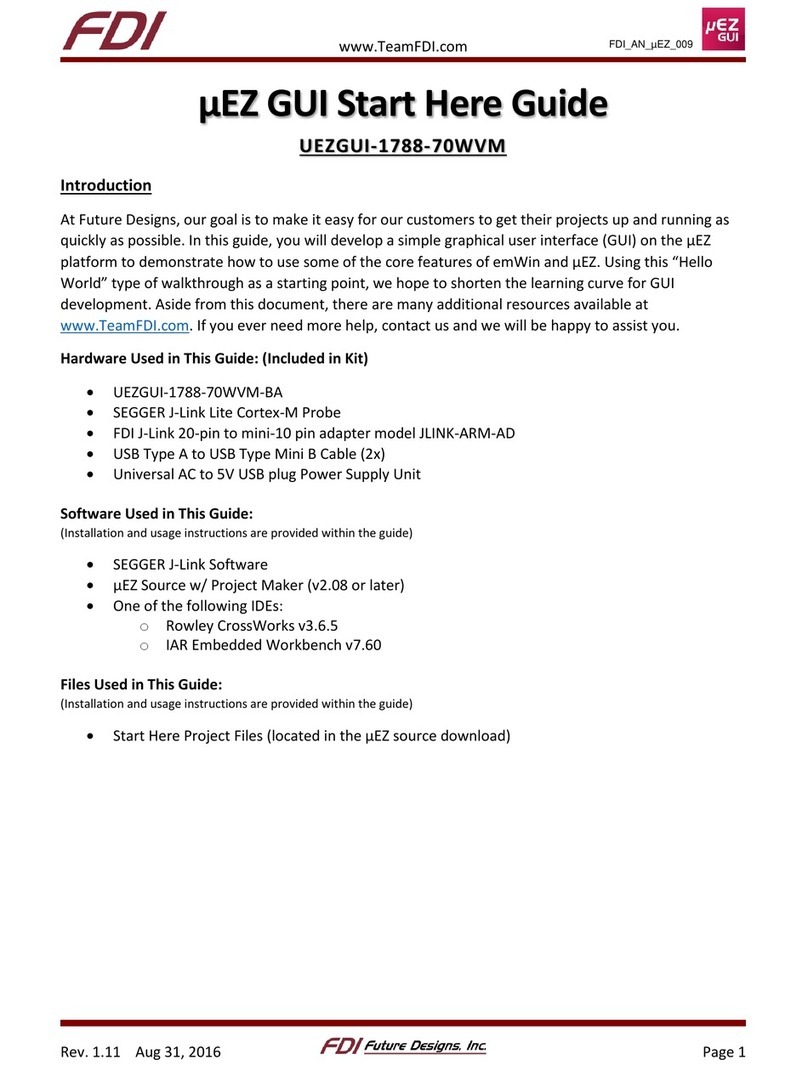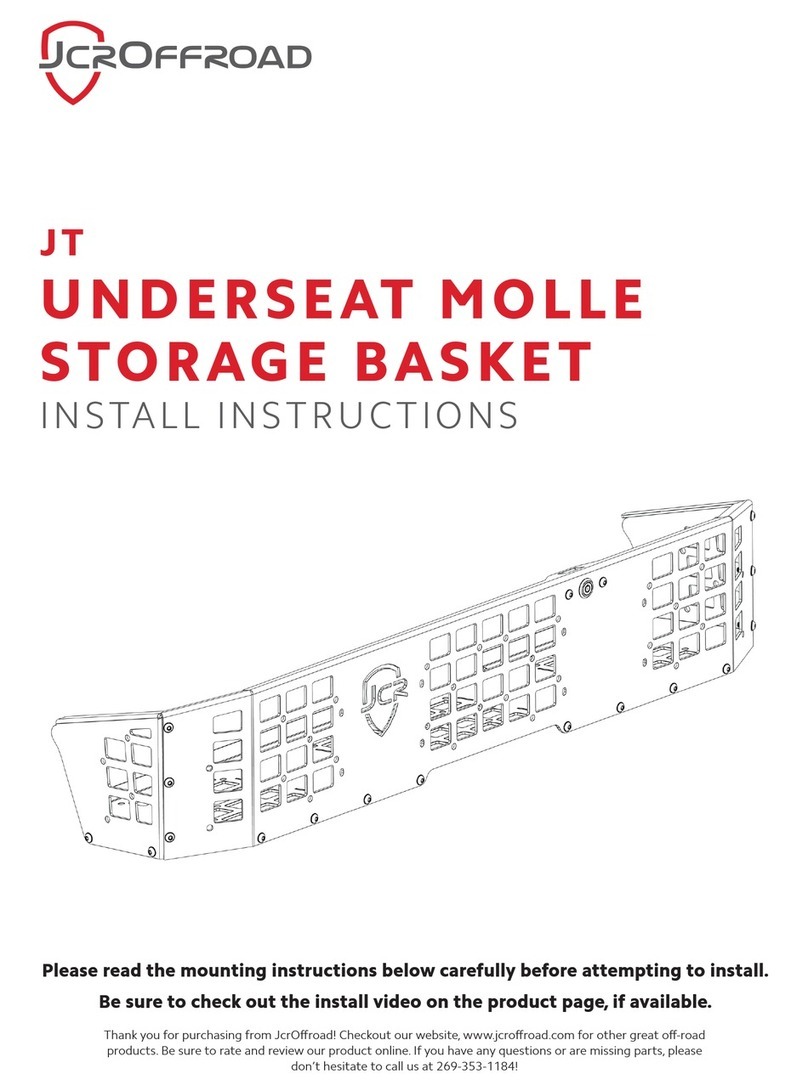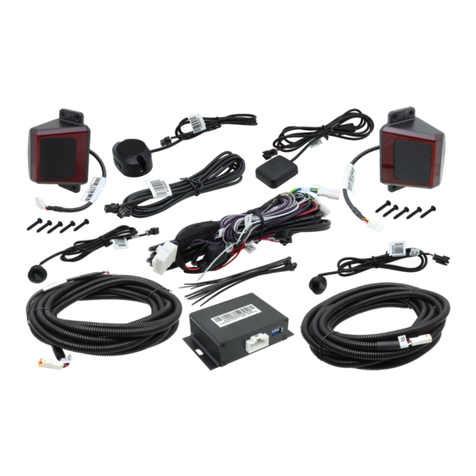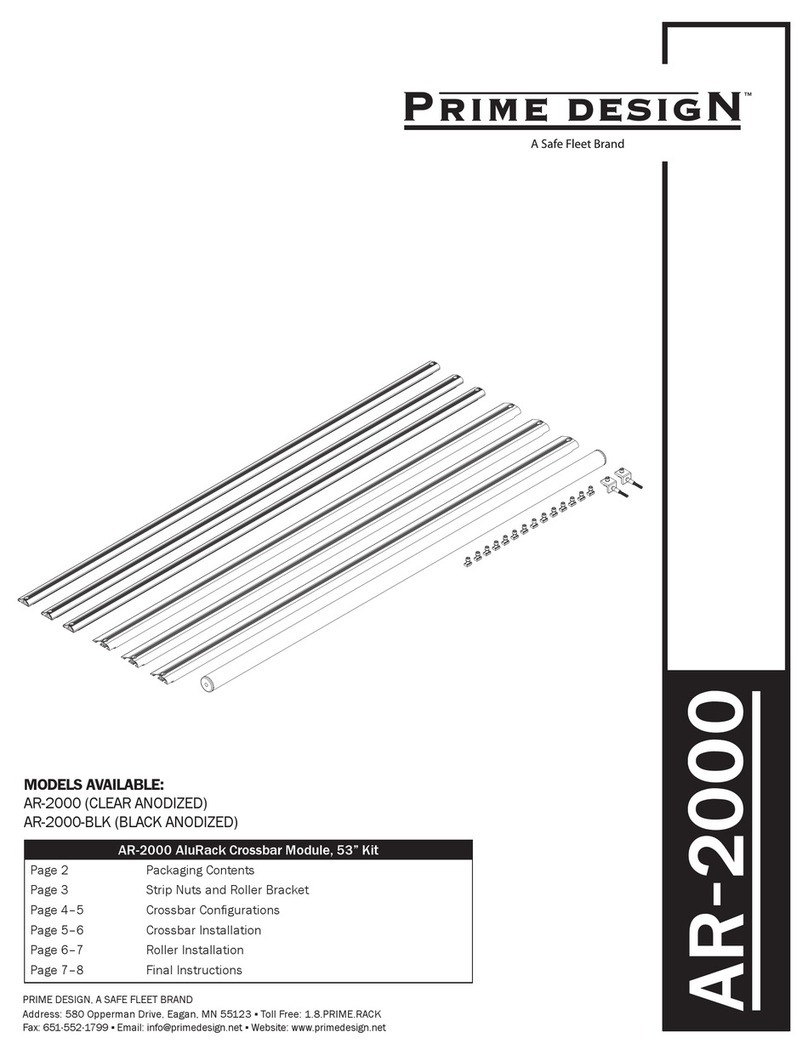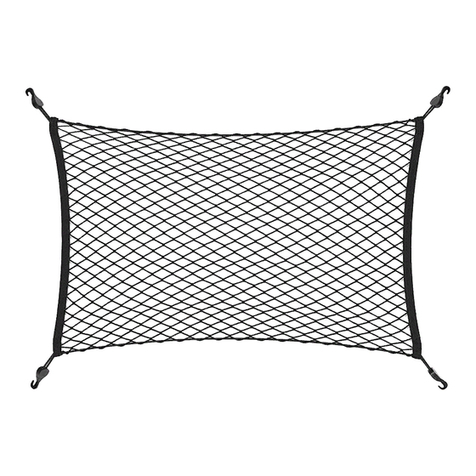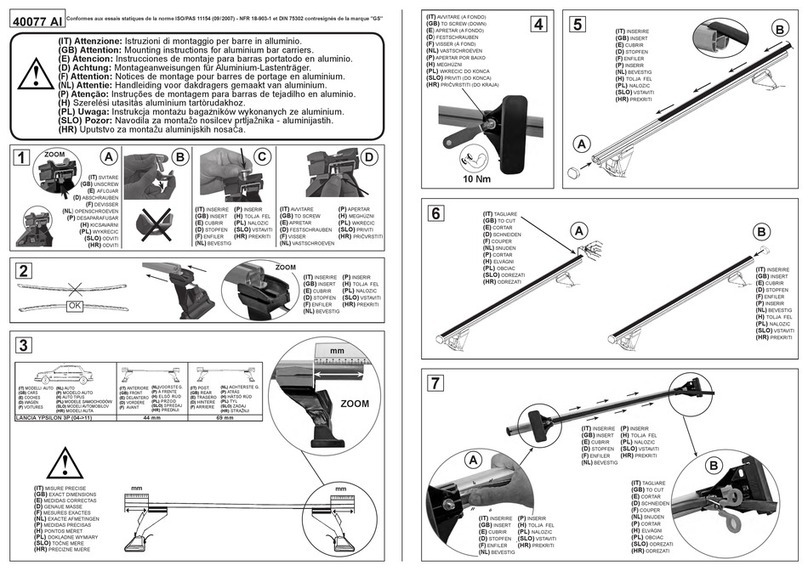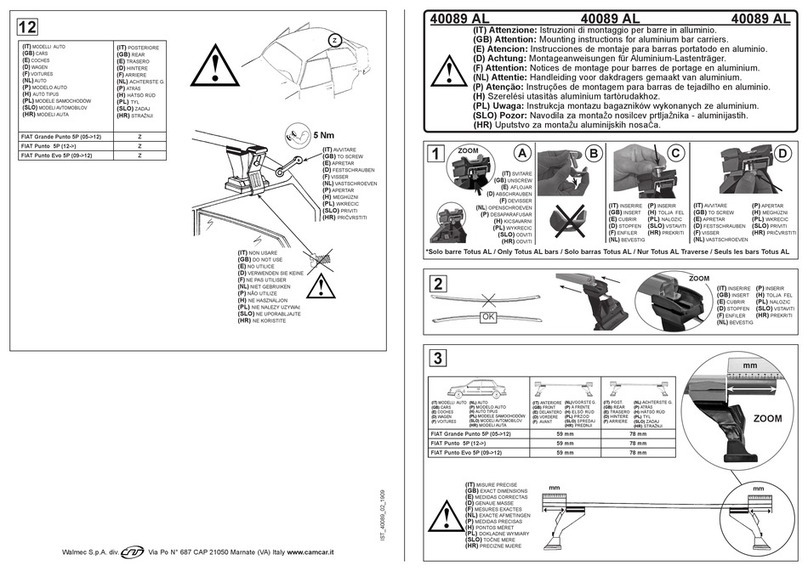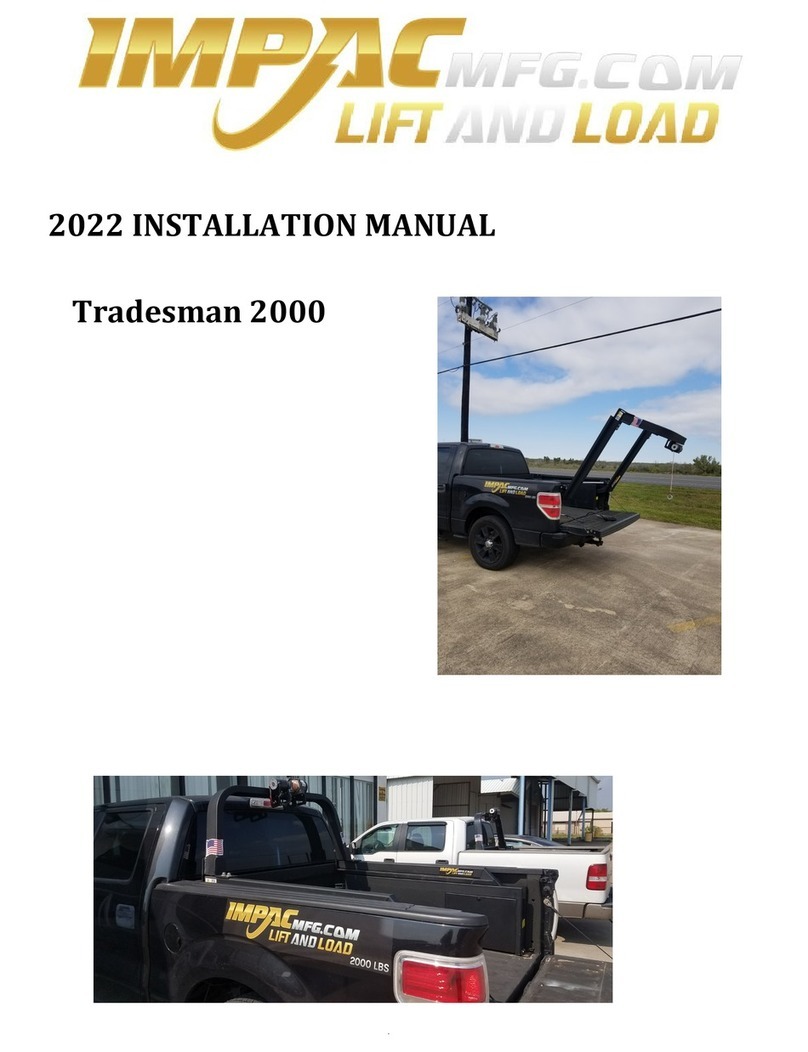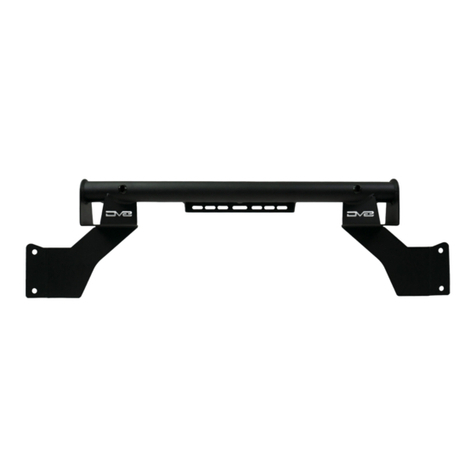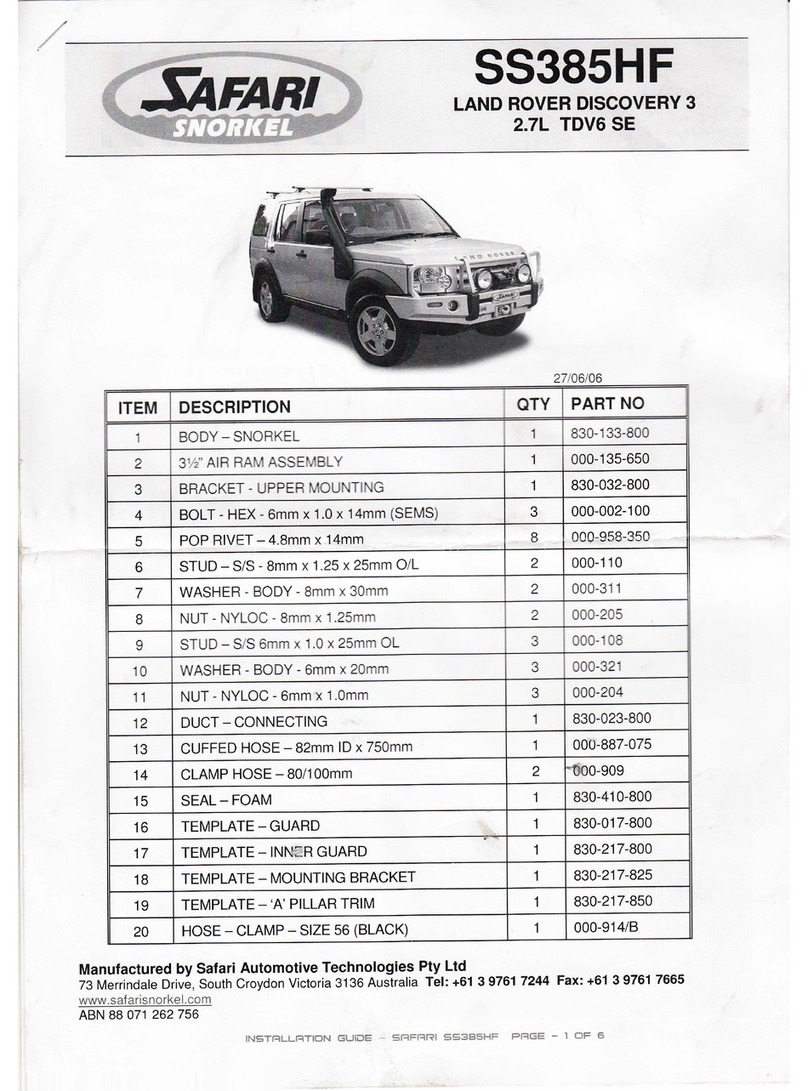Bowers & Wilkins Turnoverball 1020 User manual

B&W Trailer Hitches
1216 Hawaii Rd / PO Box 186
Humboldt, KS 66748
P:800.248.6564
F:620.869.9031
Turnoverball Gooseneck Hitch Installation Instructions
<THESE INSTRUCTIONS MUST BE GIVEN TO THE END USER>
PAGE 1 of 6
Read all installation and operating instructions along with all labels
before using this product.
Adding components such as a Turnoverball hitch to the chassis of
any vehicle can be hazardous. There is potential for unexpected
combustion of fuel, electric shock, burns, shifting or falling of
unstable vehicle, damage to vehicle, injury from tool usage and
many other hazards. This installation must be completed by
someone who is aware of the hazards involved. This person must
be knowledgeable of proper safety procedures for a vehicle
modification of this nature, and for usage of the equipment
required to perform the installation.
Without proper knowledge, towing can be a dangerous activity.
Understand all the risks involved with towing before proceeding.
For information on towing safety, see "The Trailer Handbook: A
Guide to Understanding Trailer and Towing Safety" from the
National Association of Trailer Manufacturers, www.NATM.com
and your trailer manufacturer’s owner’s manual.
Do not exceed tow or tongue rating of coupler, tow or tongue
rating of hitch, or tow or weight ratings of truck or trailer. See
vehicle and trailer manufacturer information for ratings. Exceeding
these ratings may cause damage to towing components or loss of
attachment between the trailer and truck.
Do not modify this product in any manner. Doing so could alter its
integrity and lead to a loss of attachment between the trailer and
the tow vehicle.
The Turnoverball hitch comes equipped with a 2−5/16" ball.
Trailers towed with the ball provided must have a 2−5/16" coupler.
Towing with a larger coupler could cause loss of attachment
between the trailer and the tow vehicle.
This product was designed to fit vehicles in their original, "as
manufactured" condition. Compatibility with vehicles having
replacement parts, or other modifications is not guaranteed.
Inspect vehicle for modifications before installation of this product.
Additional caution must be used when towing a wedge car trailer.
Towing stability greatly depends on keeping the center of gravity
as low as possible. Load heavy cars over the axles. Never tow
with a single car on the front of the trailer. When towing a wedge
car trailer, never exceed speeds that are reasonable for the
roadway conditions (e.g. turns, going around a curve, etc.). Failure
to account for proper trailer center of gravity and speeds that are
reasonable for the roadway conditions may cause damage to the
truck, trailer, towing components, and loss of attachment between
the truck and trailer.
Failure to comply with the safety information in these
instructions could result in serious injury or death.
WARNING
Call or Email us for
Installation Support
hitches@turnoverball.com
bwtrailerhitches.com
See Limited Lifetime Warranty at
bwtrailerhitches.com/warranty
®
MODEL 1020
2020 CHEVROLET & GMC 2500 & 3500 Trucks.
Excludes Trucks with CarbonPro beds.
A visual inspection of the hitch should be performed before each
time you tow. Regularly check that all pinned connections are
secure, and that all bolted connections are at the correct torque
specification. Check for cracks or damage to the hitch. Do not tow
with the hitch if cracks or damage outside of normal wear is found.
Towing with a hitch that has cracks or damage could result in
damage to the tow vehicle, trailer, towing components or loss of
attachment between the tow vehicle and trailer.
NOTE: All diagrams and figures shown are specific to installation
on a short bed truck. Installation on a truck with an 8’ bed requires
installing the center section in a different orientation. See step 1
under "INSTALL LATCH PIN" on page 4.
Mounting Kit Box (GNRM1020)
ITEM DESCRIPTION QTY
1Cross Member 2
2Cross Member Bracket 4
3Washer Plate 2
Center Box (GNRC920)
ITEM DESCRIPTION QTY
4Center Section 1
5Latch Pin Assembly 1
6Latch Pin Handle 1
72−5/16" Ball 1
Center Section Bolt Bag
ITEM DESCRIPTION QTY
85/8" U−Bolt 2
9Conical Springs 4
10 5/8" Lock Nut 4
5/16" X 1" Carriage Bolt 2
5/16" X 3/4" Carriage Bolt 1
5/16" Flange Nut 3
Mounting Kit Bolt Bag 1
ITEM DESCRIPTION QTY
5/8" X 4−1/2" Flange Bolt 6
5/8" Flange Nut 6
M14 X 35mm Flanged Head Bolt 4
Mounting Kit Bolt Bag 2
QTYDESCRIPTION
ITEM
6
5/8" X 4−1/2" Flange Bolt
6
5/8" Flange Nut
4
M14 X 35mm Flanged Head Bolt
2
2
2
2
6
5
1
1
3
3
8
8
7
9
10
4

NOTE: Remove all parts from the packaging and
familiarize yourself with all the parts and tools
required. Use the parts list on the front page to verify
that all parts and hardware are present.
TOOLS REQUIRED
Impact wrench or ratchet.
Sockets sized 15/16", 13mm, & 18mm
15/16", 1/2", 13mm & 18mm Box end wrench
Marking tool (pencil or permanent marker)
4" hole saw Flashlight
Drill with 11/16" bit Eye protection
Ear protection Torque wrench
Pry bar Tape measure
Lifting device (optional) Pilot hole bit
Screw driver with T−15 bits
Determine cab clearance. The Turnoverball hitch is
designed so that the ball can be inverted and stored
below the surface of the truck bed while not in use.
The ball location is determined by the truck geometry.
Measure the trailers to be towed with this hitch to be
sure that the location of the 2−5/16" ball listed in Step
5 will provide ample turning clearance between the
nose of the trailers and the cab of the truck.
WARNING: Cab clearance on short bed trucks is very
limited when towing certain trailers. Failure to ensure
that there will be adequate clearance, may result in
significant property damage, or serious injury.
PREPARE TO INSTALL
1.
Remove the spare tire and shield. Following the
vehicle manufacturer’s instructions, remove the spare
tire. The spare tire shield is held in place with two
bolts. Using a 13mm socket, remove the shield and
set aside for later re−installation. This will provide
easier access to the area where the hitch will be
installed.
Position the vehicle. Installation of the hitch requires
the installer to be under the truck bed in the area of
the rear axle. Lifting the vehicle makes this area more
accessible to the installer, and improves the
installation process.
WARNING: Lift vehicle using only equipment
designed for lifting and positioning vehicles for service.
Failure to do so may result in property damage,
serious injury, or death.
3.
2.
Installation of the Turnoverball hitch requires several
common tools and a few specialized tools. Below is a
listing of equipment used during a typical installation.
Mark the 4" hole location. Using a tape measure
hooked over the rear edge of the bed (at tailgate
end), measure the location for the hole as shown
in Figure A1. Next, locate the center of the bed by
measuring the distance between the wheel wells
and dividing by two. The center of the hole will be
at the intersection of the center of the bed and the
first distance measured.
IMPORTANT: The hitch is designed to install only at
the described location. Failure to place the 4" hole
precisely may result in added difficulty during
installation or property damage.
IMPORTANT: If the bed is equipped with a plastic bed
liner, the hole may be cut through both the liner and
the bed. However, the center of truck bed may be
more difficult to locate, and the mark may be harder to
hit if the liner slides or moves. Failure to cut the hole in
the correct location may adversely affect the install
and may result in property damage.
5.
4" HOLE LOCATION
8’ LONG BED: 45−5/16"
SHORT BED (BED LESS THAN 8’ LONG): 37−1/8"
IMPORTANT: If your truck has a spray−in bed liner
you will need to take this into account when you are
measuring, and add the thickness of the applied liner
that has been sprayed over the end of the bed.
Lower the exhaust (optional).
On some trucks,
installation may be easier if exhaust is lowered.
Un−attach the rear most tail pipe hangers from the frame
and allow the exhaust to hang freely. Re−attach the
exhaust brackets after installation is complete.
7.
PAGE 2 of 6
Cut the 4" diameter hole.
Cut the hole in the marked
location using a 4" hole saw or by marking out the 4" hole
and using a saber saw equipped with a metal cutting
blade. Remove any burrs created while cutting hole.
6.
8. Un−attach the wheel well liners. Check for the
presence of flexible wheel well liners in the truck
wheel wells. If present, three T−15 Torx screws will
need to be removed so that the liners can be folded
up and allow access to the frame, see Figure A2.
Retain screws for later re−installation.
Remove the heat shield. Locate and remove the
heat shield located above the rear axle. Use a 13mm
socket to remove the four bolts holding the heat shield
to the frame.
4.
Figure A1
Figure A2: View looking into driver side wheel well.
4" HOLE LOCATION
CENTER OF
TRUCK BED
REAR OF
TRUCK BED
T−15 SCREWS

WARNING: Most trucks have fuel lines, brake lines,
electrical wires or other vehicle systems located along
the frame rails or in the general area where
Turnoverball hitches install. Carefully examine the
locations of these systems before installation. Make
certain that these are not damaged during positioning
hitch components, drilling holes, or tightening
fasteners. Damage to these systems may result in
property damage, serious injury, or death.
INSTALL CROSS MEMBERS
PAGE 3 of 6
Cross member installation location. The cross
members for this hitch installation are designed to rest
on top of the truck frame and mount to existing
threaded holes on the top of the frame rail. To make
installation as easy as possible, locate and familiarize
yourself with these threaded holes before installing the
cross members. See Figure B1 for a top down view of
the frame with the cross members installed.
Place the forward cross member. Under the truck,
lift the end of the cross member assembly without the
cross member bracket over the exhaust towards the
passenger side shock mount, as shown in Figure B3.
Bring the cross member bracket over the brake line
bracket on the driver side of the truck and rest the flat
end of the cross member bracket on the frame. Move
the cross member so the end of the cross member
assembly with no cross member bracket is resting on
the exhaust.
Complete the cross member assembly. Pass a
cross member bracket between the exhaust and the
passenger side of the frame, see Figure B4. The flat
end of the cross member bracket will go over the
frame and the other side will bolt up to the cross
member. Bolt the two parts together so the
connections match the other side of the cross member.
Once assembled move the cross member assembly so
its just forward of the mounting holes in the frame, see
Figure B5. Hand tighten hardware only at this time.
Place the rear cross member. Attach another cross
member bracket to the remaining cross member as
shown in Figure B2, leave the 5/8" bolts loose.
Position the cross member behind the bed cross
member and 4" hole drilled in the bed, see Figure B6.
Attach a second cross member bracket to the cross
member as shown in Figures B4 & B5. Hand tighten
hardware only at this time.
1.
2.
4.
5.
6.
WARNING: Turnoverball hitch components are heavy
and may be cumbersome to handle. Failure to use
proper lifting techniques and caution when handling
these items could result in serious injury.
Prepare a lifting device (optional).
The purpose of the device is to
safely hold the hitch in position
during part of the installation. See
Figure A3 for an example. A simple
mechanical lifting device is available
for purchase from B&W.
9.
Locate parts and hardware. Locate the two cross
members and the four cross member brackets. These
will be assembled together using 5/8" x 4−1/2" flange
bolts and 5/8" flange nuts, see Figure B1.
Forward cross member assembly. Inspect one of
the cross member tubes, find the wall that contains
the welded seam. Bring a cross member bracket
and cross member together so that the tubing wall
that contains the welded seam is down inside the
cross member bracket, see Figure B2. Attach the
cross member bracket to the cross member by
passing the 5/8" bolts through the two parts, as
shown in Figure B2. Align the bolts so they are
centered in the cross member brackets slots. Attach
each bolt with a 5/8" flange nut. Push the cross
member tightly into the cross member bracket so
there is no gap between the two parts. Tighten and
torque the 5/8" nuts to 150 ft. lbs.
3.
Figure B1: View looking down over truck frame (bed not shown).
Figure B3: View looking up at bottom of bed over axle.
Figure B4 & B5: View looking up at bottom of bed over axle.
Figure A3.
Figure B2: Cross member and bracket assembly.
CROSS MEMBER MOUNTING LOCATIONS
CROSS MEMBER
PASSENGER SIDE FRAME
EXHAUST
EXHAUST
PASSENGER SIDE SHOCK MOUNT
TOP OF AXLE
CROSS MEMBER
CROSS MEMBER BRACKET
TUBE
SEAM

PAGE 4 of 6
Assemble the center section. Before the center can
be installed the latch pin assembly needs to be
attached to the center section. When installed, the
latch pin assembly must be positioned so the handle
will be on the driver side of the truck. For short bed
trucks installing the latch pin assembly on the driver
side will put the bed cross member cutout towards the
cab, see Figure C1. On 8’ bed trucks installing the
latch pin assembly on the driver side will put the bed
cross member cutout towards back of the truck, see
Figure C2. To assemble, locate the center section and
the latch pin assembly. Pass the end of the latch pin
assembly through the hole in the ball socket inside the
center section, as shown in Figure C1 & C2. While
pushing the latch pin assembly firmly against the
socket, align the two mounting holes in the pin
assembly and secure with two 5/16" X 1" carriage
bolts and flange nuts, as shown in Figure C3.
Prepare center mounting hardware. Locate four
5/8" x 4−1/2" flange bolts and the two washer plates.
Pass two bolts into each washer plate. Pass the bolts
into the cross members so that the bolt threads are
sticking out into the area where the center will install,
see Figure D1.
INSTALL LATCH PIN
INSTALL CENTER SECTION
1.
1.
Install M14 bolts. Locate the eight M14 X 35mm
flanged head bolts. Pass each bolt through the cross
member brackets and into the threaded holes in the
frame as shown in Figure E1. Refer back to Figure B1
for frame bolt locations. Do not fully tighten hardware
connections at this time.
ATTACH CROSS MEMBERS TO
FRAME
1.
2. Mount center section between cross members.
Push the front cross member forward and the rear
cross member rearward so that there is room between
them for the center section. With the latch pin
assembly on the driver side, lift the center section into
place so the raised portion of the center section
passes into the 4" hole drilled into the bed, see Figure
D2. Slide each of the cross members towards the
center section and push 5/8" bolts in to place.
Finish center assembly. Secure each bolt in the
center section with 5/8" flange nuts. Hand tighten
hardware only at this time.
3.
Figure C1: Short bed installation.
Figure C3: Latch pin assembly (short bed installation).
Figure D2: View under truck looking above differential.
Figure E1: View looking into passenger side wheel well.
Figure D1: View of cross members.
Figure C2: Long bed installation.
Figure B6: View looking up at bottom of bed over axle.
BED CROSS MEMBER CUT OUT
REAR CROSS
MEMBER ASSEMBLY
FORWARD CROSS
MEMBER ASSEMBLY

WARNING: Failure to follow the bolt tightening
sequence as listed above may result in the hitch
components being misaligned which could affect the
performance of the hitch, result in property damage,
or cause serious injury. PAGE 5 of 6
INSTALL LATCH PIN
RELEASE HANDLE
IMPORTANT: The latch pin will not function properly if
handle is not installed correctly.
Install handle. Install the latch pin release handle
by inserting it from the outside of the truck in the
driver side wheel well between the two cross
members, see Figure G1. Align the handle eyelet
with the square hole in the latch pin so the handle is
in line with the latch pin. Secure the handle to the
pin with a 5/16" X 3/4" carriage bolt and 5/16" flange
nut, see Figure G2. Tighten the nut until it is secure.
When tightening the handle, position it so that it will
not rub on the frame. Do not over−tighten and deform
the handle eyelet.
Torque hardware. Once hitch is secure, torque all
5/8" hardware to 150 ft. lbs., and all M14 hardware to
110 ft. lbs.
2.
Step 5. Tighten the eight M14 bolts connecting the
cross member brackets to the frame.
Step 4. Adjust the position of the hitch so that the
cross members are parallel to the cross members in
the truck bed. This will align the center section so it is
square with the axle.
Step 3. Tighten the four 5/8" bolts attaching the center
section to the forward and rear cross members.
Step 2. If a lifting device has not been attached to the
center section, attach a hoist or other lifting device to
the latch pin and pull the center section up so it is tight
against the bottom of the truck bed.
IMPORTANT: The hitch must be square in the truck.
If the center section is not parallel with the axle,
certain accessories to the Turnoverball hitch will not
be square with the truck.
SECURE HITCH
1.
Step 1. Before beginning, Adjust the raised portion of
the center section so it is centered in the 4" hole in the
bed.
Step 6. Tighten the six remaining loose 5/8" bolts in
the cross member brackets.
NOTE: Due to the limited space between the frame
and the bed it may not be possible to torque the M14
bolts without lifting the bed. If bed lifting is not
possible, tighten each of the eight M14 bolts as tightly
as can be achieved using hand tools. Do not over
tighten by using extensions on tools.
Modify fender liner. If a fender liner is present, it
will need to be modified by cutting a relief to allow
the handle to move freely. See Figure G3 as a
guide to cut the rear fender liner in the driver side
wheel well.
2.
Re−torque hardware. After torque on all hardware
has been set, recheck torque level on each of the 5/8"
bolted connections a second time.
3.
Tighten hitch hardware. Follow the sequence below
to tighten the hitch.
1.
Figure G1: View looking into driver side wheel well.
Figure G2: View looking up under center section.
Figure F1: View looking up under bed. (Short bed installation)
FRONT OF TRUCK
Figure G3: View looking into driver side wheel well.
STEP 3
STEP 6 STEP 6
STEP 5 STEP 5
STEP 5
STEP 5
LATCH PIN
BED CROSS MEMBER
1/2"
2-1/4"
4"
AREA TO REMOVE
EDGE OF BED FLANGE

Replace spare tire. If the spare tire was removed
prior to installing the hitch, replace it at this time.
Retract the pin. Pull the handle out all the way until it
stops then rotate it toward the cab. The handle should
stay in this position. The latch should only be put in
this open position when inverting the 2−5/16" ball or
installing a B&W towing accessory.
2.
3.
WARNING: Operating the tow vehicle while the latch
is in the open position may allow the handle to come
into contact with the rear tire. This may damage the
tire or the handle and could lead to serious injury or
death.
Lubricate 2−5/16" ball. Apply a light coating of grease
to the corners on the square shank of the 2−5/16" ball.
4.
Engage pin. Move handle toward rear of truck until the
handle retracts and engages the 2−5/16" ball.
5.
WARNING: When installed properly the latch pin will
pass through the 2−5/16" ball and fully engage through
both walls of the hitch receiver. Failure of the pin to
engage the ball and hitch properly could result in a loss
of attachment between the trailer and the tow vehicle.
PAGE 6 of 6
WARNING: The handle operates in a very tight space
within the wheel well of the truck. Use caution when
operating the handle so that your hands and fingers do
not get injured on the sharp edges of the truck, or by
getting pinched against the truck due to the force of the
spring loaded latch pin.
INSTALL SAFETY CHAIN
U−BOLTS
Drill the holes. To install the safety chain brackets, it
is necessary to drill four 11/16" holes through the truck
bed floor. Drill the holes so that they match up with the
two sets of holes on each side of the center, see
Figure H1. This may be done by drilling the 11/16"
holes from the bottom using the center as a guide, or
by drilling a smaller pilot hole from the bottom and
drilling the 11/16" holes from the top side of the bed.
1.
2.
3. Add Springs. Place a conical spring over each leg of
the U−bolts and secure with a 5/8" lock nut, see Figure
H2. Tighten the lock nut until the nut is flush with the
end of the U−bolt.
Install U−bolts. From the top side of the truck bed,
drop a U−bolt in each set of holes.
PREPARE FOR TOWING
Re−read front page. Re−read all warnings on front
page of these instructions. If you are not the end user,
make sure that users of this product receive a copy of
these instructions.
6.
WARNING: Inverting the ball while hauling heavy
loads may cause the ball to strike the truck’s
differential, drive line, or other components. Inspect
the relationship between the ball and truck
components to ensure the proper clearance. Failure to
remove the ball when hauling heavy loads may result
in property damage, injury or death. A cover to prevent
debris from entering the socket while operating without
the ball in place is available from B&W.
Replace truck components. Replace the spare tire
heat shield which was removed in the PREPARE TO
INSTALL section. If the exhaust was lowered
re−attach the tail pipe hangers. If wheel well liners
were present, re−install the T−15 Torx screws that were
removed earlier.
1.
1020 (pn 1020−1−1021) 02 03 2020
Figure H1: View of center section assembled.
Figure H2: View looking up under center section.
Copyright 2020, B&W Custom Truck Beds, Inc. ALL RIGHTS RESERVED
DRILL HOLE LOCATIONS
Table of contents
Popular Automobile Accessories manuals by other brands
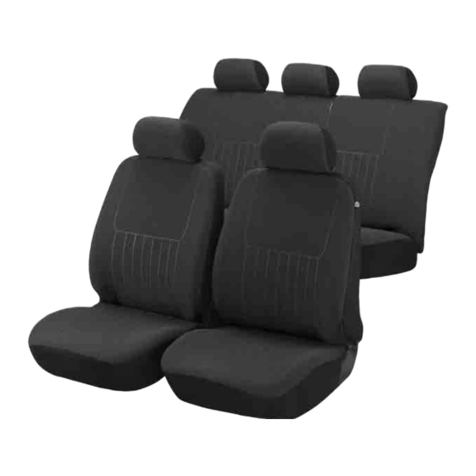
ULTIMATE SPEED
ULTIMATE SPEED 279746 Assembly and Safety Advice

SSV Works
SSV Works DF-F65 manual
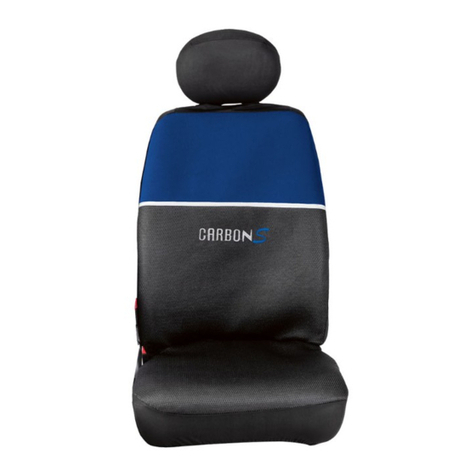
ULTIMATE SPEED
ULTIMATE SPEED CARBON Assembly and Safety Advice
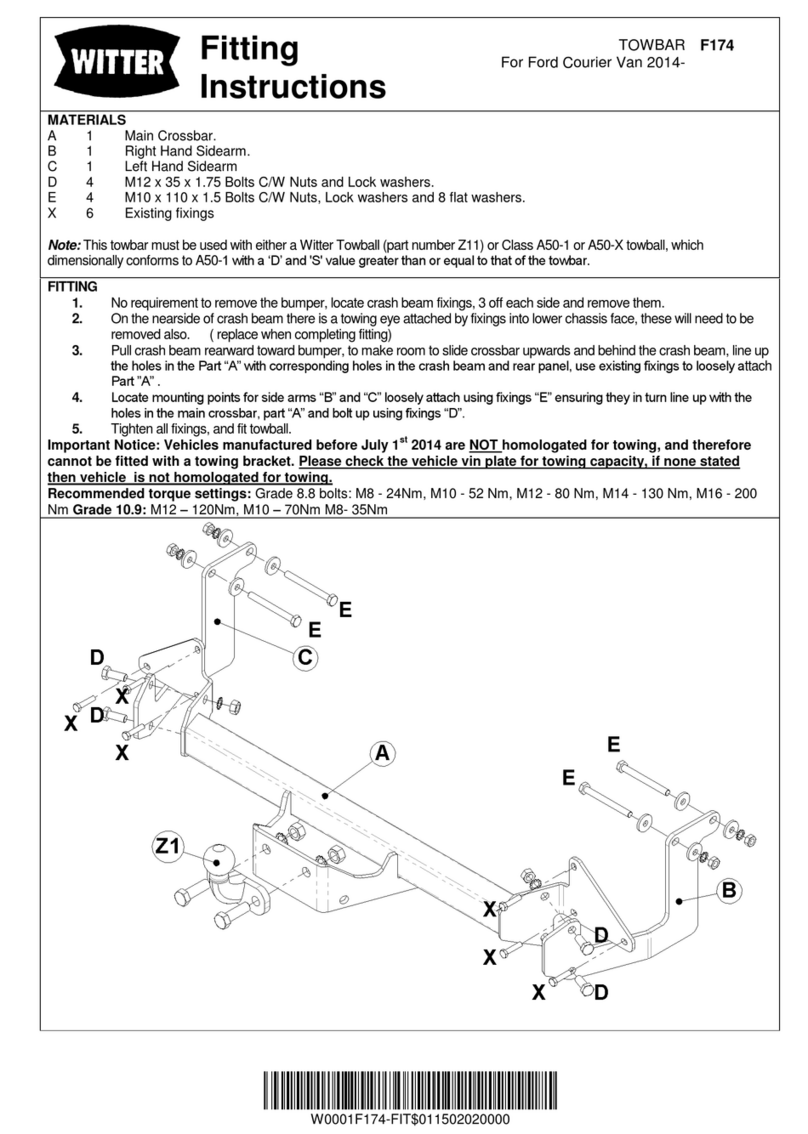
Witter
Witter F174 Fitting instructions
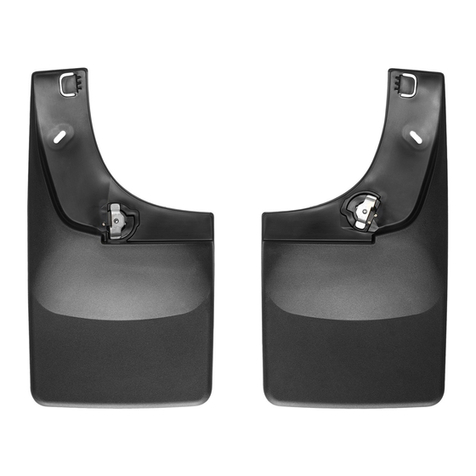
WeatherTech
WeatherTech No-Drill installation instructions
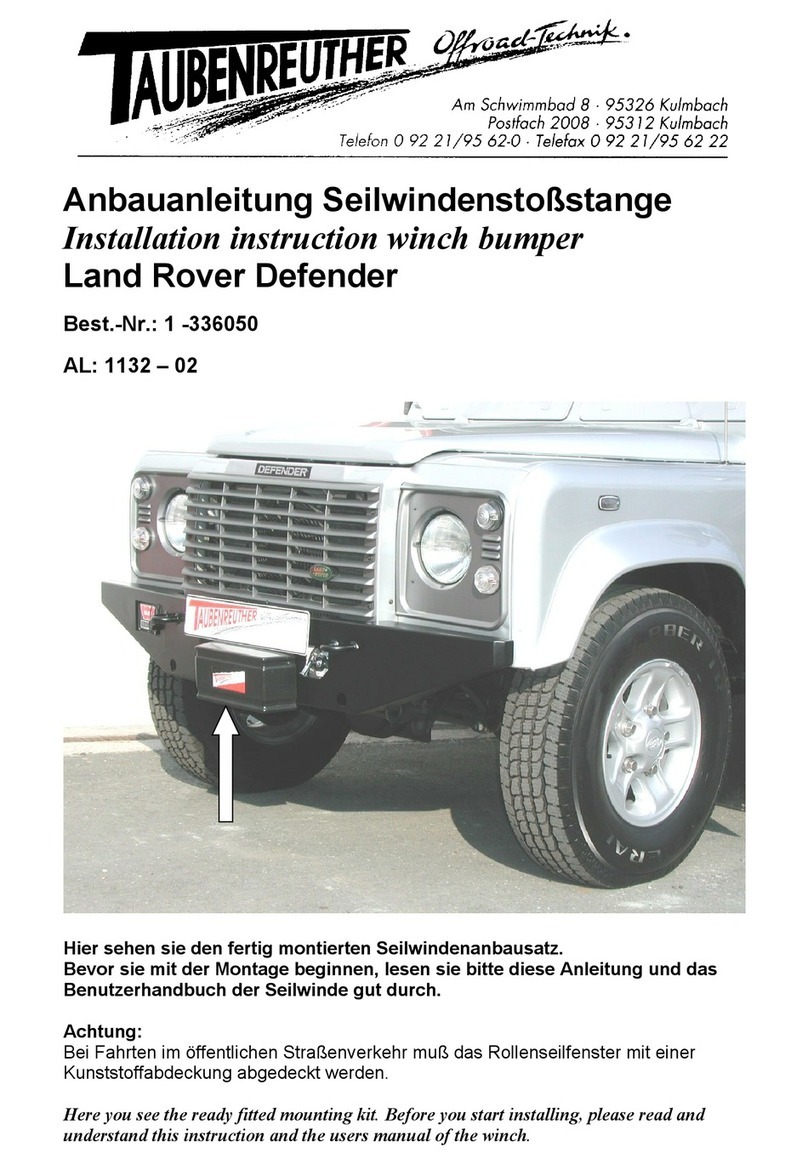
TAUBENREUTHER
TAUBENREUTHER 1-336050 Installation instruction

